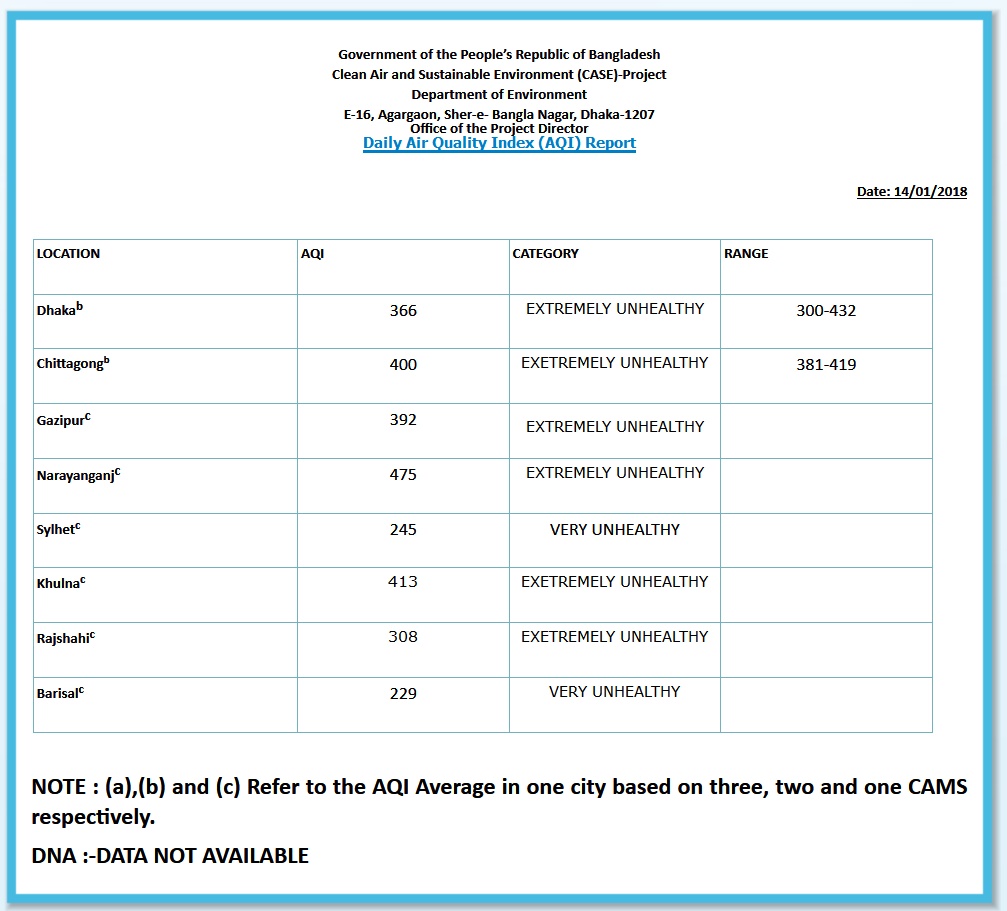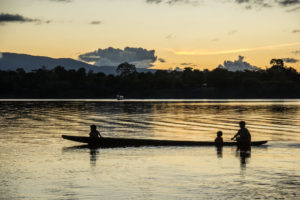Bangladesh’s national environment agency has rung an alarm bell over air quality in Dhaka, deeming it “extremely unhealthy” as the dry season begins.
On 7 January 2018, Dhaka’s air pollution levels were at 330 on the Air Quality Index (AQI), which is maintained by Bangladesh’s Department of Environment (DoE), branding the capital’s air quality “extremely unhealthy”. The air quality had been “extremely unhealthy” for four consecutive days.
Between 7 and 10 January, the severity of Dhaka’s air pollution only rose. On 7 January, air quality in the capital was at 330 points according to the AQI. By the next day, it was at 341 points; 355 points on 9 January; and 372 points on 10 January.
The AQI regards the range of 0-50 points as good air quality, 51-100 moderately good, 101-150 cautionary, 151-200 unhealthy, 201-300 points very unhealthy, and 301-500 indicates “extremely unhealthy”.

The DoE operates three continuous air monitoring stations (CAMs) in Dhaka – one in Sher-e-Bangla Nagar, one in Farmgate and the last in Darus Salam – to assess air quality. The CAMs monitor the concentration level of pollutants such as carbon monoxide, lead, nitrogen oxide, sulphur dioxide, and PM 10 and PM 2.5: particulate matter (dust, smoke and mist) that is 10 and 2.5 micrometres or less in diameter, respectively. It does not differentiate which precise pollutant is being measured in the AQI.
Nevertheless, some pollutants are more worrying than others. In December, the 24-hour average for PM 10 and PM 2.5 concentrations were higher than Bangladesh’s average air quality standard, the DoE said in its air quality report.
“The presence of other pollutants is not so serious. But the concentration of PM 10 and PM 2.5 in Dhaka’s air is most critical. The air quality is aggravating as the dry season arrives,” Ziaul Haque, a DoE director, tells The Third Pole. He adds that the smoke from brick kilns and vehicle emissions are the major causes of PM 10 and PM 2.5 in Bangladesh.
“If we could curb pollution from these two sources, air quality during the dry season would improve to a large extent,” says Haque.
This is not the first time Dhaka’s air quality has led to public health concerns. In this megacity of more than 16 million people, the air quality falls every year, causing a spike in the number of asthma and respiratory ailments. Dhaka’s air had already been deemed “extremely unhealthy” on 29 November 2017 when the AQI read 374.
Bangladesh has one wet season – from mid-April to mid-October – and one dry season. During the wet season, heavy rainfall occurs across the country. Almost every year rivers, canals, wetlands, low-lying areas – and sometimes megacities like Dhaka and Chittagong – are inundated. The wind speed during this time is higher than during the dry season. Pollutants, especially particulate matter, are washed away from the air by the rain, improving air quality.
World Bank study
The World Bank has been carrying out a study on Bangladesh’s environment. While the preliminary findings of the bank’s “Unlocking Opportunities for Clean and Resilient Growth” report are yet to be made public, The Third Pole has obtained a copy.
According to the report, the health burden of air pollution caused by PM 2.5 in urban areas stands at USD 1.93 billion, which is 1% of the country’s gross domestic product. Indoor PM2.5 air pollution causes an additional health burden of USD 1.11 billion, amounting to 0.6% of GDP.
The report states that brick kilns cause 38% of PM 2.5 pollution in Dhaka, while motor vehicles cause 19% and road dust causes 18%. Soil dust and pollution from metal smelters account for 9% and 7% of PM 2.5 air pollution respectively. Air pollution in Dhaka worsens as brick kilns start production during the dry season, according to the report.
Doctors’ dilemmas versus business opportunities
“The number of patients with asthma and other respiratory diseases reduces sharply with the start of the rainy season,” Rafiqur Rahman, the chief medical officer of the Jatiya Sangsad medical centre, tells The Third Pole. He adds that a strict ban on unfit vehicles in Dhaka would help reduce the national health cost, and the level of illness.
“Children and older people are worst affected by respiratory problems. Poor people who have no access to hospitals and clinics come to us for treatment,” says Mohammad Mohsin, the owner of the Ayesha medicine store in Dhaka’s Mirpur area.
“During the winter, the shopkeepers of many medicine stores start treating people with respiratory problems through nebulisers. When the rain starts, we see a 60% drop in sales of drugs, such as Monas, which are used to treat respiratory problems.”
It is not just the pharmacies and pharmaceutical companies who benefit from the increasing levels of smog in Dhaka – street hawkers also profit.
“In the summer, I sell locally-grown fruits such as mangos, pineapples and guava. But in the winter, I sell masks and handkerchiefs – people buy these to protect themselves from the dust and smoke,” Mohammad Mukul, a hawker, tells The Third Pole. In Dhaka, hawkers selling masks often board buses stopped at traffic signals or stuck in jams.
Irresponsible behaviour
Most of the roads in Dhaka are currently dug up due to the construction of the metro rail and the elevated expressway.
“The authorities should ensure that the dug-up portions of the road are covered. When the vehicles move along the road, the dust covers the whole area and people inhale it,” Mohammed Anisuzzaman, a stock market broker, tells The Third Pole.
Anisuzzaman lives in the Mirpur neighbourhood, where most of the roads are dug up for development works. “Due to severe traffic jams, passengers need three hours to reach Motijheel from Mirpur – a distance of only 14 kilometres – and another three hours for the return journey. Every working day, commuters on the route inhale dust and smoke for six hours,” he says.
Another commuter, Mohammad Hasanul Karim, says that hundreds of trucks carry uncovered sand, earth and bricks in Dhaka after 10pm. When they travel at high speeds, the sand and soil drops on the road.
“In many cases, a layer of sticky soil develops on the road. The frequent movement of the vehicles dries up the layer and turns the soil into dust,” says Karim. “Nobody cares about it.”
It seems there are a variety of small issues that could be tackled to deal with the air pollution hazard, but it seems the government is yet to take the issue seriously.
Kamran Reza Chowdhury is a Dhaka-based journalist








